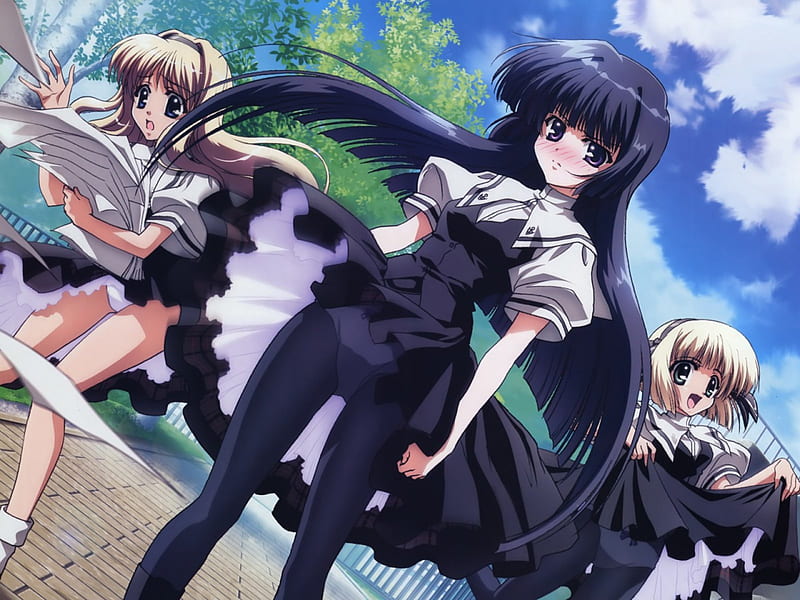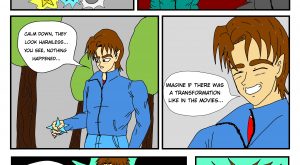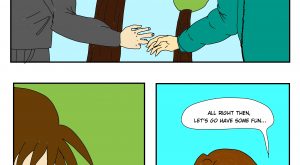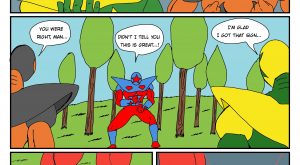H2O: Footprints in the Sand (manga/game)
H2O: Footprints in the Sand is a Japanese adult visual novel by Makura that was released on June 23, 2006 for Windows as a DVD; a version playable on the PlayStation 2 under the title H2O + followed on April 24, 2008 with adult content removed, but in its place will be additional scenarios and graphics not seen in the original release. H2O is Makura’s first game; a sequel named Root After and Another was later produced in October 2007. The gameplay in H2O follows a plot line that offers pre-determined scenarios with courses of interaction, and focuses on the appeal of the three female main characters. There are two modes of gameplay, the Blindness Effect and Normal Effect, where the former plays on the fact that the protagonist is blind, and the latter mode removes the added element of gameplay the Blindness Effect has. The story is broken into three parts: the original introduction and meeting, following by a separation and reunion, and finally ending with the protagonist choosing one of the girls and spending the rest of the game with her.
A manga adaptation, drawn by Kira Inugami, was serialized in Kadokawa Shoten‘s Comp Ace between 2007 and 2008. A 12-episode anime by the animation studio Zexcs aired in Japan between January and March 2008 on the Fukui TV television network. Several music albums have also been released. The name H2O comes from the first letter of the three main heroines: Hayami, Hinata, and Otoha. Footprints in the Sand comes from a poem; the first part of this poem appeared in episode one of the anime and the second half in the final episode.
Gameplay
The gameplay requires almost no interaction from the player as nearly the entire duration of the game is spent on simply reading the text that will appear on the screen; this text represents either dialogue between the various characters, or the inner thoughts of the protagonist. There are three main plot lines that the player will have the chance to experience, one for each of the heroines in the story. The first time the game is played, only Hayami’s plot line is available. After finishing Hayami’s plot line once, the option to choose Hinata’s plot line becomes available at the decision point in the early part of the game. Finishing Hinata’s plot line will make Otoha’s plot line available. The player must replay the game several times to view all three plot lines in their entirety. In contrast to visual novel adventure games where the text appears near the bottom of the screen leaving the rest of the window open for viewing the game’s visual content, the text in H2O appears over the entire screen in a shaded, but otherwise transparent box. However, there is an option to hide the text in order to see the background without obstruction.
The game can be played in two modes, a Blindness Effect Mode or a Normal Effect Mode. The former takes into account that the protagonist is blind, and while he can imagine what the people he talks with look like, he cannot discern the color of the world around him, which renders the artwork in an almost black and white tone, additionally giving it a stylish and dream-like appearance. As gameplay progresses and the protagonist’s condition gradually heals, this convention eventually fades away as the protagonist can now see with his own eyes the world around him. The Normal Effect Mode does not use the effect from the Blindness Effect Mode and therefore the visuals are otherwise unchanged from their originally colored state. The two modes can be interchanged at any moment throughout the gameplay.
There are three parts in the gameplay. The first part, entitled the “Past Chapter” (過去編, Kako Hen) serves to set up the story and for the protagonist to meet and get to know the characters, especially the three heroines. Following the first part, there is a time where the protagonist must leave for several years only to come back in the so-called “Reunion Chapter” (再会編, Saikai Hen) and meet the girls he knew before who have changed somewhat. After the player chooses one of the girls, the third part in the story called the “After Game” (アトゲー, Ato Gee) concludes the game, which is also where the majority of the erotic content is viewable. The story consists primarily of the first two parts, which are a flashback from the protagonist’s point of view. Within this flashback are around fifty smaller flashbacks from the past of the protagonist and the girls’. While the game is intended to be a serious drama, the gameplay is peppered with unrelated bouts of humor, which come with computer graphic artwork of the characters in a humorous situation depicted in a super deformed style. The pacing of the game is rather slow and tends to reuse the same flashback scenes. Additionally, certain flashbacks are viewable no matter which girls’ scenario is pursued and these cannot be skipped.
There is an additional “emergency” button that can be activated if the player does not want other people to know they are playing an adult game. This option shows a random piece of artwork unrelated to the game’s content out of around one-hundred images. These images are rather bizarre, one such image containing a black and white photograph of a toy horse head with red “blood” splattered around the edge of the image.
Plot
Story
H2O’s story revolves around Takuma Hirose, a blind young male junior-high school student, though the cause for his blindness is undetermined. After his mother died unexpectedly, it left a deep emotional scar on him, which caused him to become very lonely and reserved. Due to this, Takuma and his uncle move from the city out into a rural area and Takuma is enrolled into a new junior-high school. At his new school, he meets several new girls, though three of whom he gets to know the most out of anyone else; the firm and obstinate Hayami Kohinata, the kind and obliging Hinata Kagura, and the cheerful and mysterious Otoha. As Takuma interacts with these girls, his medical condition gradually begins to heal and he fully recovers.
Development and release
H2O: Footprints in the Sand was released as an adult game for the PC on June 23, 2006; an artbook came bundled with the game. A version for the PlayStation 2 entitled H2O + with adult content removed was released on April 24, 2008 by Kadokawa Shoten.[4] The PS2 version contains new computer graphics and scenarios not seen in the original release.
Related media
Manga
A manga adaptation illustrated by Kira Inugami was serialized in Kadokawa Shoten‘s magazine Comp Ace between January 26, 2007 and February 26, 2008. Two tankōbon volumes were released: the first on December 26, 2007 and the second on March 26, 2008.
Anime
A 12-episode anime adaptation produced by Zexcs, directed by Hideki Tachibana, and written by Jukki Hanada aired in Japan between January 4 and March 21, 2008 on the Fukui TV television network. A preview video was streamed on Kadokawa Shoten‘s official website for their magazine Newtype on December 19, 2007. Most notably, the video contains an English narration, a rarity for Japanese trailers. The first episode of the series was previewed on December 23, 2007 in Akihabara, Japan, and the final episode was previewed on March 20, 2008, in Machida, Japan. The first episode opens with a partial recitation of the poem “Footprints“, and the end of the poem is recited in the second half of the final episode. The anime was licensed for release in English by Kadokawa USA, but its Kadokawa Pictures USA subsidiary later closed down, therefore canceling the release.
Music
The game’s opening theme is “H2O” and the ending theme is “Tomorrow”, both sung by Monet. The maxi singles for the opening and ending themes were released at Comiket 70 on August 12, 2006. Two more theme songs used in the game were “Dream” and “Footprints in the Sand”, also both sung by Monet. A character song album for Otoha entitled Otoha’s Ghostly Bon Festival Dance (音羽の死霊の盆踊り, Otoha no Shirei no Bon Odori), sung by Mia Naruse, was released on October 22, 2006 at the DreamParty Tokyo convention. An arrange maxi single titled H2O: Prelude containing arranged versions of “H2O” and “Tomorrow”, was released on December 21, 2007. The game’s original soundtrack came bundled with the original game as a pre-order bonus. The opening theme for the anime version is “One-winged Icarus” (片翼のイカロス, Katayoku no Ikarosu) by Yui Sakakibara and the maxi single was released on January 25, 2008. The ending theme for the anime is “Kazahane” (カザハネ) by Haruka Shimotsuki and the single was released on February 22, 2008. “Footprints in the Sand” by Monet is the ending theme in the anime’s final episode.
Reception
Across the national ranking of bishōjo games in amount sold in Japan, H2O premiered at number two, and ranked in again the following ranking at number thirteen. H2O was the second highest selling game for the month of June 2006 on Getchu.com, just behind Summer Days, and for the first half of 2006 was the fourteenth highest selling game on the same website. H2O dropped to the twenty-fifth highest selling game on Getchu.com for the entire year of 2006.
| H2O: Footprints in the Sand | |

H2O original visual novel cover. Depicted are the three heroines (from left to right): Hinata, Hayami, and Otoha.
|
|
| Game | |
| Developer | Makura |
|---|---|
| Publisher | Makura (PC) Kadokawa Shoten, Regista (PS2) |
| Genre | Eroge, Visual novel |
| Platform | Windows, PlayStation 2 |
| Released | June 23, 2006 (Windows) April 24, 2008 (PS2) |
| Manga | |
| Written by | Makura |
| Illustrated by | Kira Inugami |
| Published by | Kadokawa Shoten |
| Magazine | Comp Ace |
| Demographic | Seinen |
| Original run | January 26, 2007 – February 26, 2008 |
| Volumes | 2 |
| Anime television series | |
| Directed by | Hideki Tachibana |
| Produced by | Tomoko Kawasaki Tsuneo Takechi Seiichi Hachiya Makoto Chiba Tomoko Suzuki Ryōsuke Hiramitsu Yuka Harada |
| Written by | Jukki Hanada |
| Music by | Junpei Fujita |
| Studio | Zexcs |
| Original network | Fukui TV |
| Original run | January 4, 2008 – March 21, 2008 |
| Episodes | 12 |
| Sequel | |





